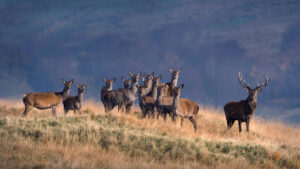ABOUT THE STUDY
Based on Anonymous Field Records from Deer Stalkers
Nicholas J. Aebischer, Christopher J. Wheatley, Hugh R. Rose.
The amount of wounding during routine culling is an important factor in the welfare of wild deer. Little information exists on factors determining shooting accuracy and wounding rates under field conditions in the UK.
In this study, 102 anonymous stalkers collected data on the outcomes and circumstances of 2281 shots. Using hot-deck imputation and generalised linear mixed modelling, we related the probability that a shot hit its target, and the probability that the shot killed the deer if it was hit, to 28 variables describing the circumstances of the shot.
Overall, 96% of deer were hit, of which 93% were killed outright. A reduced probability of hitting the target was associated with an uncomfortable firing position, too little time available, shooting off elbows or freehand, taking the head or upper neck as point of aim, a heavily obscured target, a distant target, shooting at females, lack of shooting practice and a basic (or no) stalker qualification.
An increase in the likelihood of wounding was associated with an uncomfortable firing position, shooting with insufficient time, a distant target (only when time was not sufficient), a bullet weight below 75 grains, a target concealed in thicket or on the move and an area rarely stalked.
To maximise stalking success and deer welfare, we recommend that stalkers ensure a comfortable firing position, use a gun rest, aim at the chest, use bullets heavier than 75 grains, avoid taking a rushed shot, shoot a distant animal only if there is plenty of time, fire only when the target is stationary, avoid shooting at an obscured animal, take care when the ground is unfamiliar, and do shooting practice at least once a month. The high miss rate of basic-level stalkers suggests that training should include additional firing practice under realistic shooting conditions.
This data for this study was collected in 2005 by BDS and forms the basis for ongoing improvements to Best Practice and BDS training. The data was statistically analysed and the paper published in 2014 online by PLOS one
FURTHER READING

From Local Action to National Impact: Reducing Deer Suffering After Road Collisions
After 15 years of dedicated work by the Hampshire and Isle of Wight Constabulary (HIOWC), together with essential support from Dorothy Ireland, Tony Lowry, and numerous volunteers from The British Deer Society (BDS) plus expert deer managers in Hampshire and surrounding counties, we are delighted to see the HIOWC Humane Animal Dispatch (HAD) volunteer scheme poised for a national rollout.

Support BDS and Help Protect Deer and Their Habitats
Discover how the British Deer Society is working to protect deer, their habitats, and promote sustainable wildlife management. Learn about our mission, vision, and how you can support deer welfare through education, research, and donations. Join us in making a difference for deer and the environment.

The Role of Deer Management in Conservation in the UK
Deer management plays a crucial role in supporting conservation efforts across the UK, helping to restore habitats, preserve biodiversity, and address the challenges posed by rising deer populations. This article explores the importance of balancing deer numbers with ecosystem health, highlighting the impact of culling, stakeholder collaboration, and holistic management strategies.










